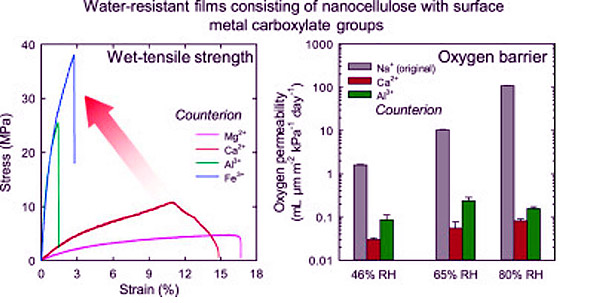Cellulosic Nanofibril With Metal Ions Have High Tensile Strength, Low Oxygen Permeability
![]() Print this Article | Send to Colleague
Print this Article | Send to Colleague
A scientific engineering abstract for an upcoming article to be published in the Journal of Membrane Science Philadelphia, Penn., USA, on Feb. 15, 2016 explaining the concept of producing water resistant and high oxygen barrier nanocellulose films with interfibrillar cross-linkages formed through the introduction of specialized metal ions has been released this week by the research team.
The abstract reports how once-dried 2,2,6,6-tetramethylpiperidine-1-oxyl (TEMPO)-oxidized cellulose nanofibril (TOCN) films with sodium carboxylate groups (TOCN–COONa) were soaked in aqueous MgCl2, CaCl2, AlCl3 and FeCl3 solutions to change the counterion to TOCNs–COOM films (M: metal ion).
Dry TOCN–COOM films had high Young's moduli (11–20 GPa) and high tensile strength (170–280 MPa). In particular, the wet TOCN films with aluminum and iron (III) carboxylates had high Young's moduli and tensile strengths of ~3 GPa and 30–40 MPa, respectively, even at water contents of approximately 470%. Additionally, the dry TOCN films with calcium and aluminum carboxylates had extremely low oxygen permeabilities of 0.08 and 0.15 mL Ám m−2 day−1 kPa−1, respectively, even at 80% relative humidity. These are outstanding values compared to those of other films previously reported. These results are explained in terms of the high water resistance of the films, which is caused by the formation of interfibrillar cross-linkages through multivalent metal ions.



